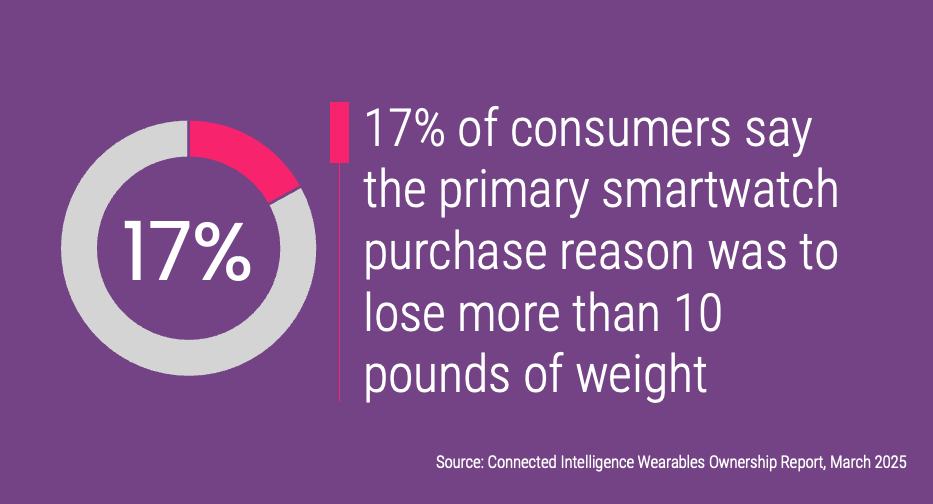
Oura takes on meal logging and more
Oura is adding glucose monitoring and meal logging to its solution. The glucose monitoring comes a few months after the company announced a strategic partnership with Dexcom, which launched an over-the-counter continuous glucose monitor (Stelo) last year. Of course, to make use of the glucose tracking you have to buy this additional product, which costs $89 per month for the annual subscription. More interesting, in some ways, is the meal logging, which uses the Oura Advisor chatbot to analyze the meal data and trends (you take a photo of the meal). The advisor gives you a breakdown of the estimated macronutrients and nutritional value, as well as providing what Oura describes as “non-judgmental insights” on what you are eating.
The Circana Take:
- Glucose monitoring is definitely on the uptake among health-conscious consumers, with more and more people slapping these little devices onto their arms. Tying the data into you other health data in a single cohesive interface provides more value, and helps to justify the cost of the Oura ongoing subscription.
- Meal tracking is key for the future of wearables. Tracking steps, exercise and so on is all very well, but without the ability to track the “intake” as well, the data does not necessarily help you lose weight. As we often point out, a two mile walk is a good thing for your exercise goals, but if the walk is really one mile to a fast-food restaurant – pause for an enormous burger – and then one mile back then… well, it would have been healthier to stay home.
- Unlike all your other exercise metrics, food monitoring is still too manual and it’s too easy to “forget” about those between-meal snacks when you are recording your food intake. Yes, I ate a healthy vegetarian dinner, but if I also scoffed down some candy… That is where the combination of the glucose monitoring and the food tracking may provide the best case solution as the AI Advisor may be able to call BS on your claimed intake, based on your glucose levels.
Oura wins first round of patent case
An initial determination from the US International Trade Commission’s Administrative Law Judge (ALJ) says that Ultrahuman and RingConn have infringed on Oura’s patent. The patent relates to the form factor of the smart ring and the ALJ confirmed that the patent is valid as an invention that existed before Ultrahuman and RingConn rings existed. The next step will be a full review by the ITC to make a final determination.
The Circana Take:
- If the ruling is upheld by the full ITC, both companies could be sent a cease and desist, effectively stopping sales of their rings. This could also impact devices already sold, as the two companies could be forced to disable some features.
- Obviously, this case is far from over and both companies will need to contest the ruling if they want to stay in the smart ring market.
- Oura has a dominant market position in the smart ring market, but will be facing pressure from smaller companies such as Ultrahuman which offers a similar solution (hence the issue at hand) but without a monthly subscription fee.
- A patent related to form factor seems rather broad: a ring is, after all, a ring-shaped forma factor. Other ring manufacturers (Samsung for example) need to take a close look at this ruling to see if they will be next on Oura’s list.
Whoop 5.0 launches
The Whoop 5.0 has launched, with the intent of broadening the target audience beyond the core focus of athletes. To be clear, that focus may not have been Whoop’s initial intent, but with a $30 subscription price and a strong focus on performance-related features, that was pretty much the reality. The new version comes in two variants: a “standard” one and the Whoop MG (for medical grade) which comes with EKG. Both are slightly smaller than the previous Whoop 4.0 with a claimed battery of 14 days.
The main updates are in the software and subscriptions. Rather than a single (and costly) option, the Whoop 5.0 has three annual subscriptions: $199 for the entry level which has basic tracking metrics (and the Whoop 5.0 hardware included); $239 for Whoop Peak which also includes stress tracking, the new Healthspan metric, a wireless charger and a Health Monitor for viewing your metrics. And at the top of the range, for those athletes, there is Whoop Life at $359 which includes EKG and blood pressure insights (and the Whoop MG hardware).
The Circana Take:
- Whoop is, well, different. The subscription includes the hardware, so there’s no up-front cost in addition to the subscription, unlike solutions such as smart rings. The hardware is faceless: this is not a smartwatch. Heck, it doesn’t even tell the time. As such, it screams “I care about fitness” and that is a wearable statement in itself.
- Whoop had to broaden its target audience to appeal to a broader base. The upsurge in smart ring adoption directly competes against Whoop. Indeed, the products all aim to do the same thing, with no screen or additional apps. As such, Whoop caters to the audience that doesn’t want to wear a smart ring.
- Because it is in the same field (effectively) as a smart ring, we still see this (and rings) as a relatively niche product. Most wearable owners still want a screen on their wrist, at least so they can see what time it is.